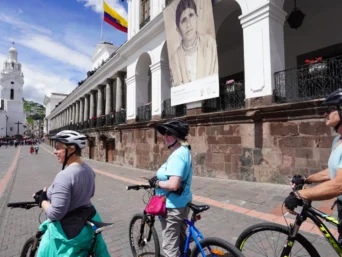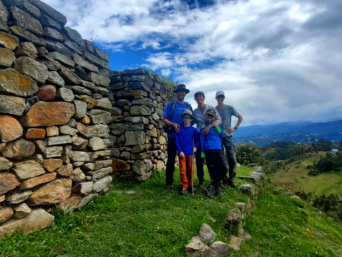Begin in the Galapagos, where you'll traverse volcanic landscapes, snorkel in marine sanctuaries like Los Túneles, and cycle along trails flanked by mangroves and flamingo-studded wetlands. Encounter the grandeur of giant tortoises and the playful curiosity of sea lions, all under the guidance of passionate naturalists. Marvel at the towering Sierra Negra Volcano and immerse yourself in the vibrant underwater world of Tintoreras Islet, where white-tip reef sharks and penguins mingle.
Then, venture deep into the Amazon, gliding through serene waters to remote Kichwa communities. Experience their traditions, savor meals steeped in local flavors, and sleep under a canopy of stars. Kayak along the Arajuno River, where toucans, monkeys, and otters animate the dense foliage. Visit a wildlife sanctuary dedicated to conserving the region's delicate biodiversity and trek through ancient forests rich with medicinal plants.
Conclude your journey with a restorative retreat at hot springs, a haven of thermal pools. Throughout, savor moments of discovery, reflection, and connection with nature’s most sublime wonders. This expedition is more than a journey—it’s a story you’ll carry for a lifetime.

- Up-Close Wildlife Encounters in the Galápagos: Marvel at iconic species like the blue-footed boobies, giant tortoises, sea lions, and marine iguanas. Snorkel alongside tropical fish, sea turtles, and even playful sharks in crystal-clear waters.
- Authentic interaction with Galápagos Locals: Experience the vibrant culture of the islands by meeting the locals and learning about the islanders’ way of life. Enjoy a delicious seafood feast prepared with fresh, locally sourced ingredients while listening to stories of life on the islands.
- Amazon region’s biodiversity: Spotting toucans, monkeys, and other species.
- Immersive Kichwa Experience in the Amazon: Venture into the Amazon rainforest to engage with an indigenous Kichwa community. Learn traditional practices, from crafting to cooking, and join in ceremonial activities.
- Wellness at Hot Springs: Indulge in relaxation at natural thermal pools. Treat yourself to a rejuvenating spa experience, combining mineral-rich waters with serene mountain views.
- Culinary Diversity from the Amazon to the Islands: Savor the unique flavors of Ecuador, from fresh ceviches in the Galápagos to hearty Amazonian dishes like maito (fish cooked in palm leaves).
- Eco-Friendly Accommodations: Stay in carefully selected properties that prioritize sustainability and blend seamlessly into their natural surroundings, offering breathtaking views and an intimate connection with nature. Glamping in the Amazon get disconnected and in direct contact with nature.
- Support for Local Education and Community: Contribute to meaningful initiatives that benefit local children and families, creating a lasting positive impact.
Snorkeling
Hiking
Paddling
Swimming
Culture
Wildlife
Biking
Wine and Beer tasting
Hot springs and wellness
Year around
5 years old
Full Itinerary
Arrival Day
In the evening, at 6 PM, we invite you to join us for an important briefing session. This will be an opportunity to meet your guide and fellow adventurers, as well as to gather essential information and tips for the exciting days ahead.
Overnight: Swissotel or similar
Meals included: none

Galapagos Welcome by the Giants of Santa Cruz and refreshing at local brewery
Upon landing, you’ll pass through the Galapagos migration counters, where a Naturalist Guide from the Galapagos National Park will greet us, assist with luggage and guide you through the process to your next mode of transport—a combination of road and water transfer to Santa Cruz Island.
Our first stop will be the highlands of Santa Cruz, a lush and cooler contrast to the arid coastal regions. Our destination is El Chato Reserve, a haven for giant tortoises in their natural habitat. After a tasteful lunch, you’ll have the unique opportunity to observe these gentle giants as they roam freely, graze, or wallow in mud pools, which help protect them from parasites and keep them cool.
During our exploration, your guide will share insights about the tortoises’ behavior, diet, and incredible adaptations that allow them to thrive in such a unique environment.
In addition to the tortoises, the highlands are teeming with other wildlife, including vibrant bird species like Galapagos flycatchers, Darwin’s finches, and vermilion flycatchers. A highlight of the highlands is a walk through one of the island’s lava tunnels, formed by ancient volcanic activity. These subterranean passages are a geological wonder, providing an up-close look at the volcanic origins of the Galapagos. Your guide will explain how these tunnels were created and the role they play in the island’s history and ecosystem. Later-on we’ll visit a local craft brewery nestled in the highlands. Here, you’ll taste a selection of beers brewed with local ingredients, capturing the unique flavors of the Galapagos. You´ll learn about the brewing process and how the brewery integrates sustainable practices to operate within the delicate ecosystem of the islands. This family-owned place caters to everyone, featuring a thoughtful selection of alcohol-free beverages.
Once in Puerto Ayora, you’ll have time to unwind and explore the town at your leisure. We recommend taking a stroll along the vibrant streets, where you’ll find charming cafes, artisan shops, and inviting waterfront restaurants.
For a magical experience, head down to the boat docks after dark to spot blacktip sharks, rays, and other marine creatures attracted by the lights of the harbor. It’s the perfect way to end your day in Santa Cruz, blending the town’s lively charm with the island’s captivating natural wonders.
Overnight: Hotel La Isla or similar
Meals included: Breakfast and lunch
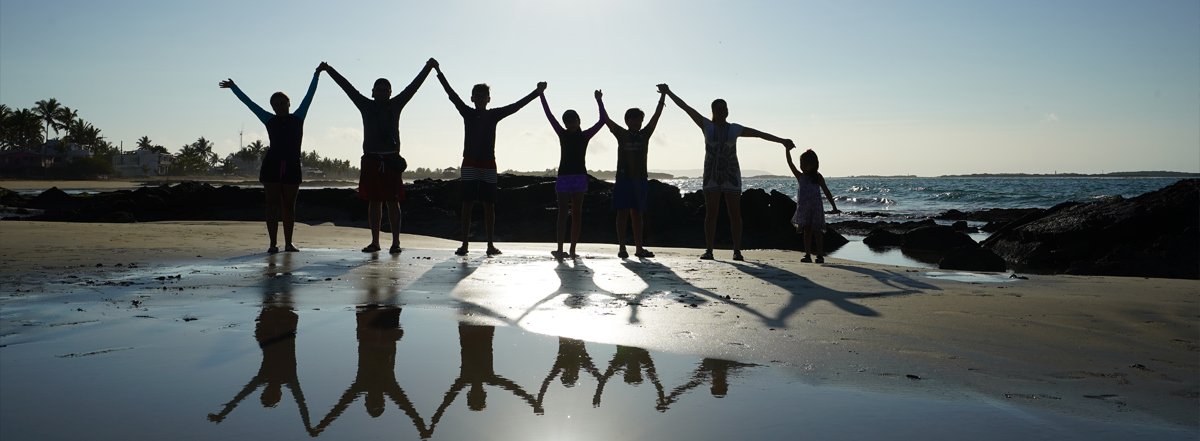
A kayaking adventure through Puerto Ayora Coastline and navigation to Isabela Island
Enter a secluded, calm bay where sea turtles often swim gracefully near the surface. Follow the lush mangrove-lined shorelines, observing sally lightfoot crabs scuttling over volcanic rocks and herons wading in the shallows.
Complete your adventure with a refreshing snorkel in a crystal-cove, swimming among tropical fish before we paddle peacefully back to Puerto Ayora.
Back to town, you’ll have some free time to enjoy lunch. We will suggest several excellent dining options, many offering fresh seafood and stunning oceanfront views, giving you a great taste of the Galapagos' culinary delights.
In the afternoon, we’ll board a water taxi to Isabela Island, the largest and one of the most pristine islands in the archipelago. Isabela's rugged charm and unspoiled landscapes make it a haven for wildlife, including marine iguanas, flamingos, giant tortoises, and even the unique Galapagos penguins, the only penguin species found north of the equator.
Upon arrival on Isabela, our representative will assist you with transfer to your hotel. He´ll advise of great places for dinner. You’ll check in at your hotel and have the rest of the evening to relax and absorb the tranquil island atmosphere. Consider taking a leisurely stroll along the beach, or simply unwind as you watch the sunset paint the sky in vivid colors over the Pacific Ocean, a perfect ending to your first day in the Galapagos.
Overnight: Hotel Cormorant or similar
Meal included: Breakfast
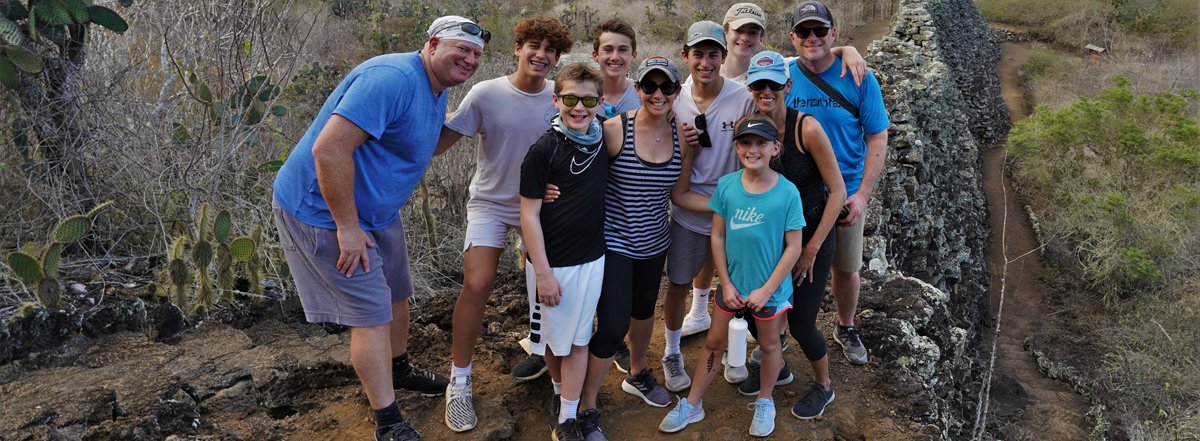
Biking through biodiversity: Tortoise trails, wetlands, a journey of conservation and kayaking the Tintoreras Islet “white tip shark” heaven
Our journey begins with an exploration of Isabela’s Wetlands, a network of lagoons, swamps, and mangroves teeming with wildlife. These wetlands are a haven for tropical birds such as flamingos, herons, and finches, creating a vibrant spectacle of color and sound. As we pedal through this ecosystem, we’ll immerse ourselves in its natural beauty and gain insight into the crucial role it plays in the island’s biodiversity. Next, we’ll visit the historic Wall of Tears, a poignant reminder of the island's past. This massive stone wall was constructed by prisoners during the island’s penal colony era in the mid-20th century. Our guide will share stories of the hardships endured by those who built it, providing a sobering glimpse into this chapter of Isabela’s history.
Continuing our ride, we’ll stop at Playa del Amor, or Love Beach, known for its striking black lava formations and the largest population of marine iguanas on the island. These unique creatures, found only in the Galapagos, can often be seen basking on the rocks or swimming in the ocean, foraging for algae underwater—a fascinating display of their adaptability.
A key highlight of the day is the visit to the Tortoise Breeding Center, a cornerstone of the Galapagos conservation efforts. Here, we’ll learn about the impressive initiatives undertaken to protect and repopulate the islands with giant tortoises, whose numbers were once critically low due to human activity. We’ll see tortoises at various stages of their life cycle, from tiny hatchlings to majestic adults, and gain a deeper appreciation for the dedication of those working to ensure their survival.
After a morning of exploration through these rich environments, we’ll return to Puerto Villamil for enjoying a well-deserved lunch. In the afternoon we’ll embark on a thrilling kayaking excursion towards small islets formed by jagged volcanic rock that creates narrow underwater canyons teeming with life. Kayaking here is a truly unique experience, paddling in the middle of the Pacific Ocean, surrounded by dramatic volcanic landscapes and the rich marine life of the Galapagos. As we glide across the serene waters, we’ll encounter playful Galapagos penguins darting through the water, blue-footed boobies diving from above, and curious sea lions swimming around our kayaks. The peacefulness of the open sea, combined with the incredible wildlife encounters, makes this a magical and unforgettable adventure.
Overnight: Hotel Cormorant or similar
Meals included: Breakfast and lunch
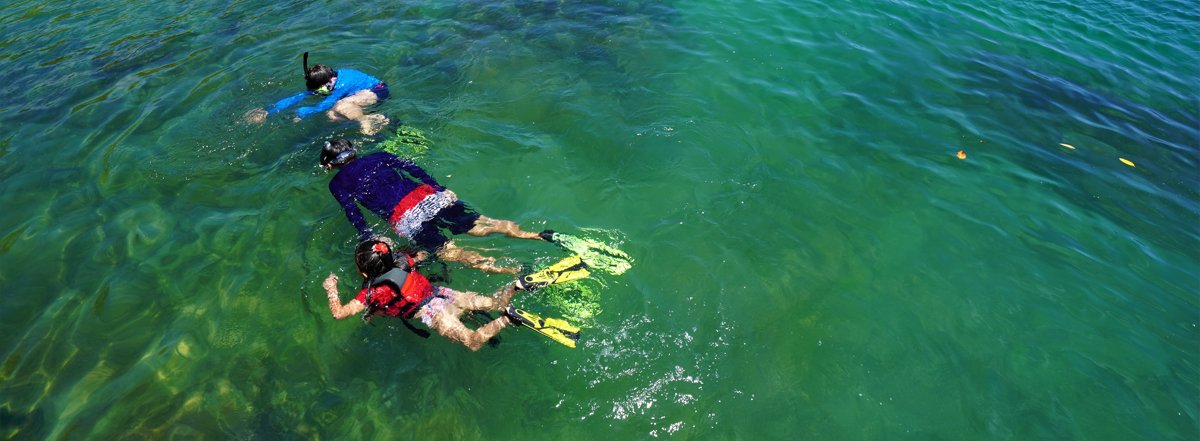
A breathtaking trek to the Sierra Negra Volcano
As we hike along the rim of the caldera, we’ll observe the fresh volcanic material left behind from the most recent eruption in 2018, a powerful event that reshaped parts of the caldera’s interior. On clear days, you can enjoy panoramic views of the island, including the distant Elizabeth Bay, a pristine area known for its unique mangroves and marine life. Along the trail, keep an eye out for native bird species such as the Galapagos hawk, finches, and the vermilion flycatcher flitting through the sparse vegetation.
After exploring Isabela's highlands, you’ll have free time to unwind and soak in the golden hues of the sunset, accompanied by the gentle sound of waves lapping the shore.
If you’re feeling energetic and wish to further explore, you can hike to nearby beaches like Concha Perla—a magical spot perfect for a refreshing swim or simply relaxing by the water. It’s the ideal way to end a day filled with discovery and connection to this extraordinary island.
Overnight: Hotel Cormorant or similar
Meals included: Breakfast and boxlunch.

A Day of snorkeling spectacle: Discovering the wonders of Los Tuneles and El Finado
The underwater experience at Los Tuneles is just as magical. With crystal-clear waters, you’ll have the chance to snorkel among a vibrant array of marine creatures, including: • White-tip reef sharks resting in the shade of the tunnels. • Sea turtles gracefully gliding through the calm waters. • Golden and spotted eagle rays cruising over the sandy seabed. • Colorful reef fish, from parrotfish to damselfish, darting in and out of the tunnels. • Playful sea lions, always curious and interactive with snorkelers.
Los Tuneles offers a rare opportunity to swim in a sheltered and serene environment, making it a favorite for travelers and marine wildlife alike. After enjoying a delicious lunch served on board, we’ll head to El Finado, another spectacular snorkeling site nearby. This secluded spot was once used by local fishermen as a resting place and is now a thriving underwater sanctuary. It is ideal for spotting: • Manta rays and stingrays gliding gracefully through the sea. • Octopuses camouflaged among the rocky seabed. • Starfish in vibrant colors adorning the ocean floor. • Schools of fish shimmering in the sunlight, creating an underwater kaleidoscope.
For those who prefer to stay on the boat, the views of the islet’s rugged volcanic landscape and its surrounding turquoise waters are equally mesmerizing.
As the sun sets, we’ll unwind with a relaxing Ecuadorian wine-tasting social hour—a perfect time to reflect on the day’s adventures. You’ll have the chance to connect with fellow travelers, share stories, and soak in the tranquil ambiance of Isabela Island. Afterward, we’ll get ready and hit the town’s streets, ending the evening with a delicious dinner at a charming local eatery.
Overnight: Hotel Cormorant or similar
Meals included: Breakfast, lunch and dinner
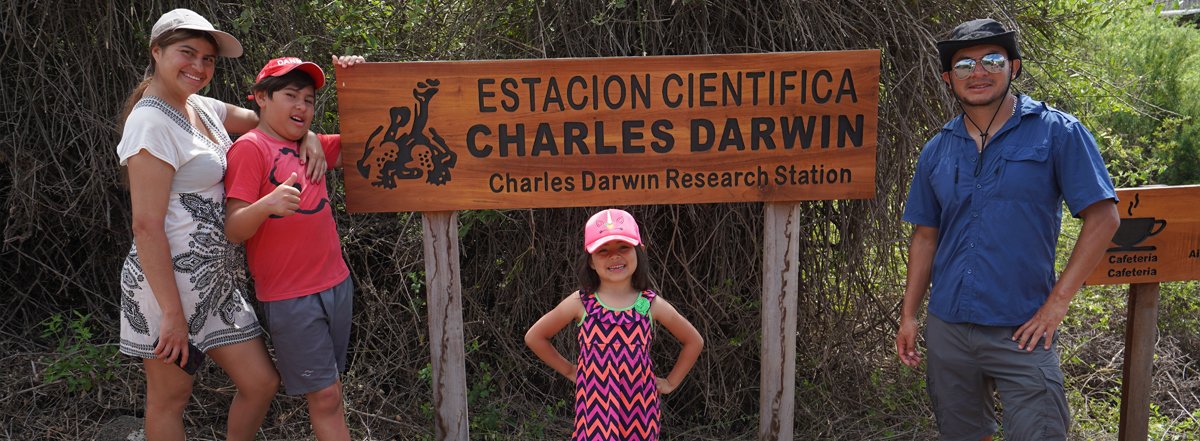
Return to mainland
Once you land in Quito, our team will warmly welcome you and assist with your transfer to your hotel in the city.
Overnight: Swissotel or Similar
Meals included: Breakfast

Kayak Adventure in the Amazon and Shamanic encounter
Our journey begins on the Punin River entrance, where we’ll embark on a serene kayaking experience. Gliding through the calm waters, surrounded by towering trees and the calls of exotic birds, you’ll feel fully immersed in the jungle’s rhythm.
The Arajuno River is calm and classified as Class I, making it perfect for beginners. No prior kayaking experience is needed—our expert guides will provide instruction to ensure a smooth and enjoyable paddle. As we glide along the river, you'll witness the breathtaking biodiversity of the Amazon rainforest. Keep an eye out for vibrant wildlife along the riverbanks, such as monkeys, colorful toucans, and spot other bird species that inhabit the shoreline.
After approximately two hours of paddling, we’ll arrive at our riverside glamping site, nestled in a serene and tranquil setting. Enjoy a refreshing drink upon check-in and unwind before a delicious traditional dinner is served.
During the evening, a local shaman will visit our camp to share insights into the spiritual practices and medicinal traditions of the jungle—an unforgettable cultural experience.
Overnight: Arajuno River Amazon Glamping
Meals included: Lunch, Dinner
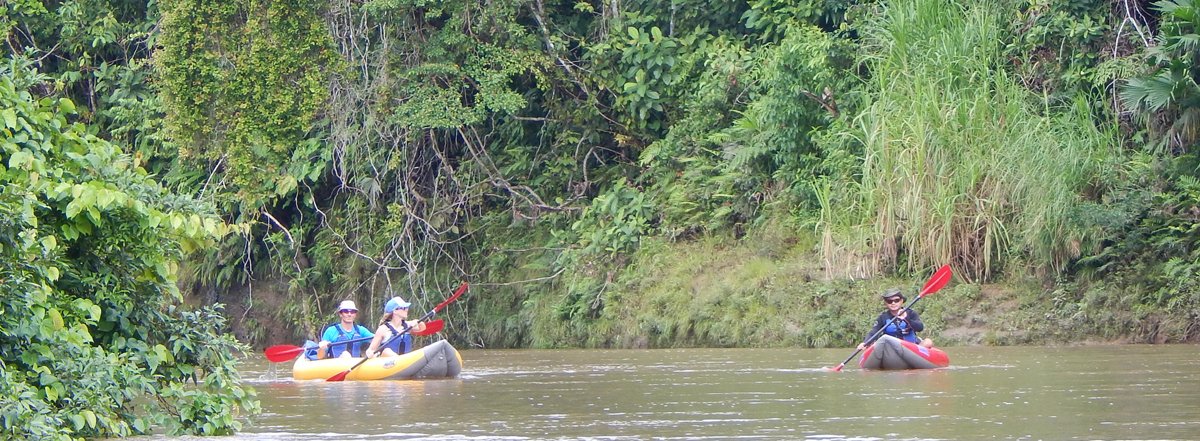
Parrot Clay Lick, Jungle Trek, & Kichwa Community Visit
Later, we prepare for a 2–3 hour educational jungle trek (length adjusted to the group’s pace). Along the trail, your guide will introduce you to the diverse flora and fauna of the Amazon and explain the delicate balance of this unique ecosystem. In the afternoon, we’ll paddle toward a nearby Kichwa community, where the spirit of the jungle and the traditions of its people come alive. Upon arrival, you’ll be welcomed warmly by the community members who will guide us in setting up our campsite and share insights into their daily lives.There could be a rare opportunity to meet with a shaman woman, a keeper of ancestral wisdom and healing practices. The community will invite us for lunch, a "catch-to-table" culinary experience. Fresh fish, caught earlier in the day, which will be expertly cooked using traditional Amazonian techniques. Wrapped in bijao leaves and roasted over an open fire, the meal will feature other ingredients foraged from the jungle, providing a delicious taste of local flavors.
As part of your support by taking this tour, today we’ll visit the school and the computing center funded by these trips. If time allows join a friendly soccer game with the children. You’ll also have the opportunity to purchase beautiful, handmade crafts from local women artisans, supporting their sustainable livelihood.
Back at the campsite, unwind with a refreshing swim in the river or gather around the bonfire. For those who are interested, there’s an optional night hike to discover the fascinating nocturnal life of the rainforest, including insects and amphibians.
Overnight: Arajuno River Amazon Glamping
Meals included: Breakfast, lunch and dinner

Farewell Paddles, Wildlife Lagoon & Volcanic Hot Springs
Next, a short 15-minute drive brings us to a hidden gem: a private reserve and serene lagoon. Here, we’ll glide silently by canoe through calm waters, keeping an eye out for lively troops of monkeys, vibrantly colored birds, and other rare wildlife that call this pristine ecosystem home. After a satisfying final lunch, we begin our scenic return to Quito. The route winds through breathtaking Andean landscapes, where misty cloud forests give way to sweeping valleys. On clear days, you might even spot the majestic, snow-capped peak of Antisana Volcano dominating the horizon.
But the day isn’t over yet! We’ll make a rejuvenating stop at natural volcanic hot springs, where geothermal waters rich in minerals await. These soothing pools are known for their healing properties—perfect for relaxing tired muscles, improving circulation, and offering a moment of deep calm amid stunning natural surroundings.
Take your time to unwind in the warm waters, enveloped by lush vegetation and the peaceful whispers of the mountains. It’s a beautiful opportunity to reflect on the profound experiences, stunning landscapes, and meaningful connections you’ve made throughout your journey in Ecuador. We’ll arrive back in Quito, leaving you with refreshed spirits and unforgettable memories.
Overnight: Swissotel or similar
Meals included: Breakfast, lunch
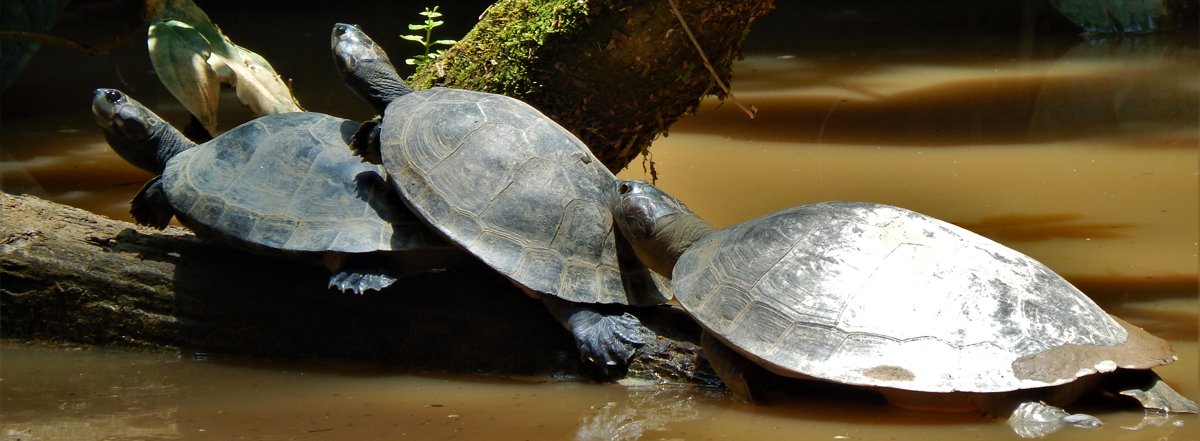
Departure Day
Meals included: Breakfast
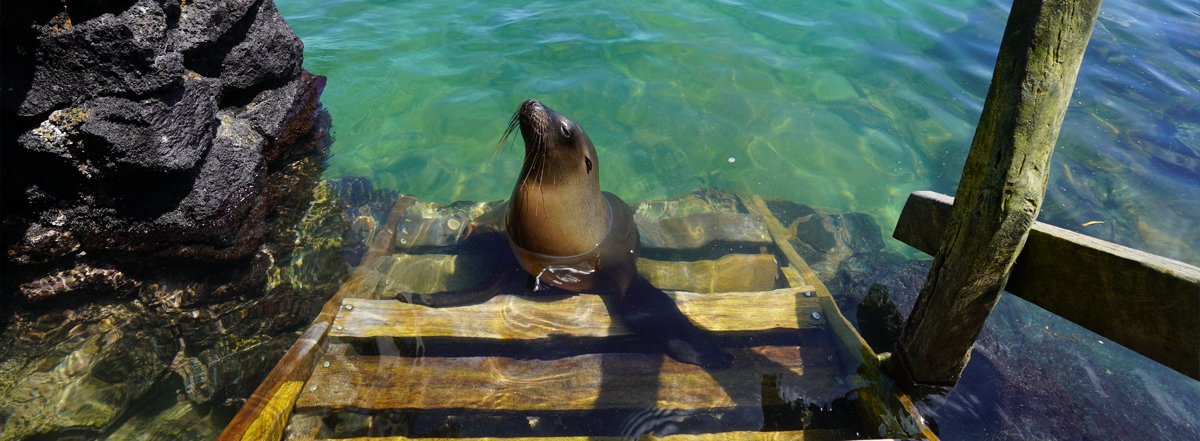
Airport transfers
Top Experienced Certified English-Speaking Guide
Private mainland transport
Land and water transport in Galapagos
Inter-island flight Isabela to Baltra
Accommodation for ten nights
Meals according to the Itinerary
Water and snacks at all time
Biking gear Galapagos: Hybrid bikes, certified helmets and gloves
Biking gear mainland: (Trek quality bikes, front Rockshox suspention with hydraulic brakes, 1 x 10 speeds), certified helmets and gloves
Paddling gear Galapagos: Seat on top double kayaks, lifejackets and paddles
Paddling gear Amazon: Expedition-grade inflatable kayaks, lifejackets and paddles
Snorkeling gear: Mask and fins
Hiking gear: Rubber boots
All fees to reserves and museums (except Galapagos)
International flights
Domestic flights Quito – Baltra – Quito
Galapagos transit control card INGALA
Galapagos National Park fee
Isabela Island fee
Meals not mentioned in the itinerary
Tips for guides and drivers
Travel insurance (mandatory)
Optional activities
Itinerary Disclaimer: Even though we have a detailed itinerary, changes can be made by your guides, due to weather or safety reasons. Please also note that none of the wildlife sightings mentioned on the itinerary are guaranteed.
Visas and Passports: Make sure you check your visa and passport validity and requirements per country. It is important your passport is valid for at least 6 months before your travel.
Accommodation: We strive to use charming places that are unique and provide stellar service.
Single Supplement Costs: Generally, apply to solo travelers who do not have a roommate to share accommodations with.
Gear: We always make sure our guests have top of the line gear from well-known and reputable international brands as we understand that the best gear gives extra confidence to our travelers.
Transportation: Driving time can take more than expected in Ecuador, as it is a small country with roads meandering through the Andes Mountains. We assure your comfort during transit no matter the size of the group, while in the Galapagos the speed boat from Santa Cruz to Isabela can be a bit challenging if you are not use to travel by boat, so we highly recommend to carry some seasickness medicine with you.
Level of Activity: This trip is considered as 2 out of 5. No prior experience is required and your guides will always brief you about safety and proper use of gear on every leg of the trip. The biking on Isabela is quite easy on mostly flat terrain along the coastline, the kayaking in Galapagos is on a calm area, and in the Amazon is class I, this means there are not big rapids – an easy paddle. Also there will be a transport support for the majority of the activities in the case that someone wants to take a break or just want to relax.
Weather and Elevation in Galapagos: Although the islands are located on the equator, the Humboldt Current brings cold water to them, causing frequent drizzles during most of the year. The weather is periodically influenced by the El Niño events, which occur about every 3 to 7 years and are characterized by warm sea surface temperatures, a rise in sea level, greater wave action, and a depletion of nutrients in the water. During the season known as the garúa (June to November), the temperature by the sea is 22 °C (72 °F), a steady and cold wind blows from south and southeast, frequent drizzles (garúas) last most of the day, and dense fog conceals the islands. During the warm season (December to May), the average sea and air temperature rises to 25 °C (77 °F), there is no wind at all, there are sporadic, though strong, rains and the sun shines. Weather changes as altitude increases in the large islands. Temperature decreases gradually with altitude, while precipitation increases due to the condensation of moisture in clouds on the slopes. There is a large range in precipitation from one place to another, not only with altitude, but also depending on the location of the islands, and also with the seasons. The precipitation also depends on the geographical location. During March 1969, the precipitation over Puerto Ayora, on the southern coast of Santa Cruz was 249.0 mm (9.80 in), while on Baltra Island, the precipitation during the same month was only 137.6 mm (5.42 in). This is because Baltra is located behind Santa Cruz with respect to the prevailing southerly winds, so most of the moisture gets precipitated in the Santa Cruz highlands. There are significant changes in precipitation from one year to another, too. At Puerto Ayora, the precipitation during March 1969 was 249.0 mm (9.80 in), but during March 1970, it was only 1.2 mm (0.047 in). On the larger islands, the pattern of generally wet highlands and drier lowlands impacts the flora. The vegetation in the highlands tends to be green and lush, with tropical woodland in places. The lowland areas tend to have arid and semi-arid vegetation, with many thorny shrubs and cacti, and almost bare volcanic rock elsewhere.
Weather and Elevation in Mainland: In Ecuador the weather can be vary greatly depending on which side of the Andes you are traveling to, so it is highly recommended to come ready for all kinds of weather. When they say “Ecuador, All in One Place” they mean it! The altitude determines the temperature and the higher you go the colder it gets. Don’t let the geographic location of the country fool you. Even at a mere 15,000 feet the temperatures can feel like those of a winter in the northern United States. In Galapagos, although the islands are located on the equator, the Humboldt Current brings cold water to them, causing frequent drizzles during most of the year. The weather is periodically influenced by the El Niño events, which occur about every 3 to 7 years and are characterized by warm sea surface temperatures, a rise in sea level, greater wave action, and a depletion of nutrients in the water. During the season known as the garúa (June to November), the temperature by the sea is 22 °C (72 °F), a steady and cold wind blows from south and southeast, frequent drizzles (garúas) last most of the day, and dense fog conceals the islands. During the warm season (December to May), the average sea and air temperature rises to 25 °C (77 °F), there is no wind at all, there are sporadic, though strong, rains and the sun shines. Weather changes as altitude increases in the large islands. Temperature decreases gradually with altitude, while precipitation increases due to the condensation of moisture in clouds on the slopes. There is a large range in precipitation from one place to another, not only with altitude, but also depending on the location of the islands, and also with the seasons. The Galapagos Islands exhibit significant local variations in rainfall due to their topography and prevailing winds. A clear example of this can be seen by comparing the southern and northern sides of Santa Cruz Island. During a visit to the amazon region, in 4 or 5-day visit, you will often see more or less the same amount of rain and sunshine. The Rainier Season in the Amazon Runs from December to June, with temperatures ranging from 23°C (73°F) to 30°C (86°F) and frequent rains throughout April and May. The Rainy Season has its pros because many plants have evolved to fruit and flower during the rainy season, a phenomenon which often attracts birds and primates to the water’s edge and grants visitors the chance to observe them more frequently. The Drier Season in the Amazon Lasts from July to November, with temperatures from 26°C (78°F) to 40°C (104°F), with less rain, though showers are still possible. The Dry Season also offers its own set of benefits, for its during this time that the water gets lower and attracts animals that you won’t often see during the rainy season. Beach nesting birds are everywhere, as there are more beaches present during this time.
Sustainability: We do our best to not produce any trash; we believe that recycling is not enough so we try to avoid using any plastic or materials that pollute our environment. Every day we work towards being a zero-waste tour operator and our staff is well trained to leave the least impact possible in our service areas. We also work with local indigenous communities in the different regions. By doing so we are able to teach our guests about the rich culture Ecuador, all the while helping the people preserve their traditions and lands. By working directly with local peoples, we are able to create a sustainable touristic income for the community.
Guides: All our guides have a professional background from the Tourism University; this means they have a degree in guiding, so their knowledge and skills when leading a group are top-notch. Each guide has many years of experience and they all have taken additional courses for other outdoor activities as well as have International First-Aid certifications. On top of all of this, they are all extremely personable and strive to deliver travel experiences of a lifetime.
Heath advices: No vaccinations needed for this trip.
This packing list is designed for your 11-day trip, considering the unique climate of both the Galapagos Islands and the Amazon Region. Remember that the weather can change, and versatility is key.
Important Note on Inter-Island Flight:
Please be aware that for your inter-island flight from Isabela to Baltra, the maximum luggage allowance is 25 pounds (approx. 11.5 kg) per person. Luggage exceeding this limit may be subject to an extra charge at the airport. It is highly recommended to pack a small duffel or backpack for the flight and leave any non-essential items in your main luggage at the hotel in Quito, which will be available to you upon return.
Clothing (Layering is Essential)
- Tops (5-7): Lightweight, quick-drying T-shirts and long-sleeved shirts (for sun protection and evening).
- Bottoms (3-4):
- 2-3 pairs of shorts (lightweight, quick-drying).
- 1 pair of lightweight, breathable pants (ideal for evenings and protecting against insects/sun).
- Swimwear (2 suits): Having an extra one allows for a dry suit each day.
- Light Jacket/Fleece: For cooler evenings in Quito and on the inter-island boats.
- Waterproof Rain Jacket or Poncho: A must-have for unexpected showers.
- Undergarments: A sufficient supply for the trip (quick-drying materials are a bonus).
- Socks (5-7 pairs): Lightweight, moisture-wicking socks for hiking. Avoid cotton.
Footwear
- Comfortable Walking Shoes/Sneakers: For exploring Quito and general walking.
- Sturdy Hiking Shoes: Essential for the Sierra Negra Volcano trek and other trails on Isabela. Ensure they are broken-in.
- Sturdy Sandals (e.g., Tevas or Keens): Perfect for water activities, walking around town, and wearing on boats.
- Flip-Flops: For relaxing at the hotel.
Gear & Accessories
- Daypack (small): For carrying water, camera, snacks, etc., during daily excursions.
- Reusable Water Bottle: To stay hydrated and reduce plastic waste. Water and snacks are provided on the tour, but this is a great addition.
- Dry Bag: Highly recommended for protecting your camera, phone, and other electronics during boat tours and water activities.
- Sun Hat: With a wide brim for sun protection.
- Sunglasses: With a strap to prevent them from falling off during boat tours.
- Headlamp or Flashlight: Useful for walking in towns at night, as some areas may be dimly lit.
- Binoculars: Highly recommended for spotting birds, marine life, and other animals from a distance.
Health & Personal Items
- Sunscreen (high SPF, reef-safe): Essential for protecting your skin from the intense equatorial sun. Look for “reef-safe” formulas to help protect the delicate marine ecosystem.
- Insect Repellent (DEET recommended): Crucial for preventing insect bites.
- Personal Medications: Any prescription medications, plus a small first-aid kit with pain relievers, antihistamines, antiseptic wipes, and band-aids.
- Toiletries: Pack in travel-size containers.
- Motion Sickness Medication: If you are prone to seasickness, it’s wise to bring medication for boat transfers.
- Hand Sanitizer:
- Aloe Vera/After-Sun Lotion: For soothing sunburns.
Documents & Money
- Passport: Must be valid for at least six months beyond your departure date.
- Flights Itinerary: All flight information and confirmation numbers.
- Travel Insurance Information: This is mandatory.
- Credit/Debit Cards: Inform your bank of your travel plans.
- Cash: A mix of small US dollar denominations for tips, souvenirs, and small purchases.
- Copies of Important Documents: Keep digital copies on your phone or in the cloud.
Optional Items
- Camera with Extra Batteries/Memory Cards: A waterproof or underwater camera is ideal for snorkeling.
- Small Notebook and Pen: For journaling your experiences.
- Book/E-reader: For downtime.
- Small, lightweight packable towel: For quick-drying needs.
- Portable Power Bank: To keep your devices charged on the go.
- Small Backpack or Duffel Bag: For the inter-island flight to manage the weight limit.
By packing smart and light, you’ll be well-prepared to fully enjoy this incredible adventure without the hassle of extra baggage fees.
NOTE: Laundry is available almost at every location, this helps traveling light too.
Read more, Terms & Conditions.
Regular Season Price:
PRICE
$3100/per person
All premium features
Every sunday
Go private
We are ready to meet your needs and put together an unforgettable experience.





